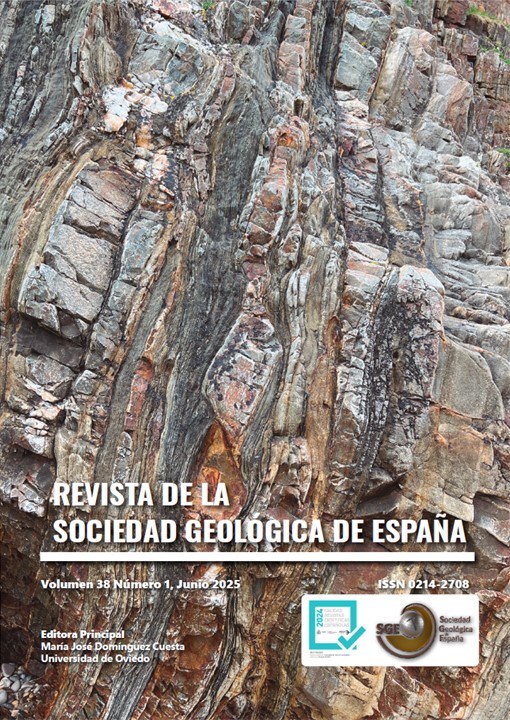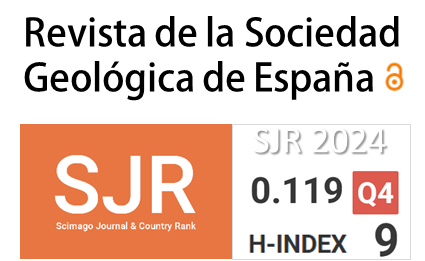Caracterización estratigráfica y sedimentológica de la Formación Sardinero (Cretácico Superior) en Costa Quebrada (Cantabria)
DOI:
https://doi.org/10.55407/rsge.115620Palabras clave:
Cuenca Vasco-Cantábrica, calciesferas, hemipelágico, truncación sedimentaria, Costa QuebradaResumen
La Formación Sardinero (Turonense–Campaniense) está compuesta por alternancias rítmicas de margas y calizas nodulosas, depositadas en ambientes marinos abiertos de baja energía, en el sector externo de una plataforma (rampa) mixta siliciclástica-carbonatada. En la zona de Costa Quebrada (norte de la Cuenca Vasco-Cantábrica), esta formación alcanza un espesor de hasta 450 m, lo que indica una elevada tasa de sedimentación (~5 cm/ka), aunque inferior a la registrada en sectores más subsidentes de la cuenca; y marca la re-inundación y reactivación de la sedimentación tras una etapa sin depósitos. Inicialmente, dichos depósitos fueron predominantemente siliciclásticos (lutitas margosas laminadas), alternando con etapas de sedimentos hemipelágicos carbonatados (calizas nodulosas ricas en calciesferas y glauconita). Posteriormente, se generalizó la acumulación de caparazones calcáreos de organismos planctónicos junto con arcilla, limo y arena procedentes de sectores más someros de la cuenca. La sucesión registra una tendencia somerizante que culmina con la colmatación progresiva de la cuenca, registrada por las calizas arenosas de la Formación Cabo de Lata (Campaniense Superior-Maastrichtiense). En este trabajo se describen e interpretan los principales tipos de facies y asociaciones de facies, destacando la presencia de superficies de truncación intraformacional, originadas por la tectónica sin-sedimentaria de la cuenca.
Citas
Bahamonde, J.R., Kenter, J.A.M., Della Porta, G, Keim, L., Immenhauser, A., Reijmer, J.J.G., 2004. Lithofacies and depositional processes on a high, steep-margined Carboniferous (Bashkirian–Moscovian) carbonate platform slope, Sierra del Cuera, NW Spain. Sedimentary Geology, 166: 145–156. https://doi.org/10.1016/j.sedgeo.2003.11.019
Bathurst, R.G.C., 1987. Diagenetically enhanced bedding in argillaceous platform limestones: stratified cementation and selective compaction. Sedimentology, 34: 749–778. https://doi.org/10.1111/j.1365-3091.1987.tb00801.x
Boudagher-Fadel, M.K., 2008. Evolution and Geological Significance of Larger Benthic Foraminifera, Vol 21. Chapter 5, the Mesozoic large benthic foraminifera: The Cretaceous, 215–295. UCL Press, U.K. https://doi.org/10.1016/S0920-5446(08)00005-8
Buchbinder, B., Benjamini, C., Mimran, Y., Gvirtzman G., 1988. Mass transport in Eocene pelagic chalk on the northwestern edge of the Arabian platform, Shefela area, Israel. Sedimentology, 35: 257–274. https://doi.org/10.1111/j.1365-3091.1988.tb00948.x
Burchette, T.P.,Wright, V.P., 1992. Carbonate ramp depositional systems. Sedimentary Geology, 79: 3–57. https://doi.org/10.1016/0037-0738(92)90003-A
Cendrero, A., Díaz de Terán, J.R., Flor, E., Francés, E., González J.R., Salas L., 1986. Guía didáctica de la franja costera entre la Península de la Magdalena y Liencres (Cantabria) - Universidad de Cantabria, Consejería de Educación del Gobierno de Cantabria. TOMOS I y II.
Christ, N., Immenhauser, A., Wood, R., Darwich, K., Hachenberg, A., 2015. Petrography and environmental controls on the formation of Phanerozoic marine carbonate hardgrounds. Earth-Science Reviews, 151: 176–226. https://doi.org/10.1016/j.earscirev.2015.10.002
Dott, R.H., Bourgeois, J., 1982. Hummocky stratification: significance of variable bedding sequences. Geological Society of America, Bulletin, 93: 663– 680. https://doi.org/10.1130/0016-7606(1982)93<663:HSSOIV>2.0.CO;2
Drzwiecki, P.A., Simo, J.A., 1997. Carbonate platform drowning and oceanic anoxic events on a mid-Cretaceous carbonate platform, south-central Pyrenees, Spain. Journal of Sedimentary Research, 67: 698–714. https://doi.org/10.1306/D426861C-2B26-11D7-8648000102C1865D
Dunham, R.J., 1962. Classification of carbonate rocks according to depositional texture. En: Clasification of Carbonate Rocks (W.E. Ham, Ed.), Memoir American Association Petroleum Geologists, 1: 108–121. https://doi.org/10.1306/M1357
Einsele, G., 1982. Limestone-marl cycles (Periodites): diagnosis, significance, causes—a review. En: Cyclic and event stratification (G. Einsele, A. Seilacher, Eds.), Berlin, Springer. 8–53. https://doi.org/10.1007/978-3-642-75829-4_2
Ekdale, A.A., Bromley, R.G., 1988. Diagenetic microlamination in chalk. Journal Sedimentary Petrolology, 58: 857–861. https://doi.org/10.1306/212F8E8B-2B24-11D7-8648000102C1865D
Elrick, M., Hinnov, L.A., 2007. Millennial-scale paleoclimate cycles recorded in widespread Palaeozoic deeper water rhythmites of North America. Palaeogeography, Palaeoclimatology, Palaeoecology, 243: 348–372. https://doi.org/10.1016/j.palaeo.2006.08.008.
Esmerode, E.V., Lykke-Andersen, H., Surlyk, F., 2007. Ridge and valley systems in the Upper Cretaceous chalk of the Danish Basin: contourites in an epeiric sea. En: Economic and Palaeoceanographic Significance of Contourite Deposits (A.R. Viana, M. Rebesco, Eds.). Geological Society of London Special Publication, 276: 265–282. https://doi.org/10.1144/GSL.SP.2007.276.01.13
Esmerode, E.V., Surlyk, F., 2009. Origin of channel systems in the Upper Cretaceous Chalk Groupofthe Paris Basin. Marine and Petroleum Geology, 26: 1338–1349. https://doi.org/10.1016/j.marpetgeo.2009.05.001
Feuillée, P., Rat, P., 1971. Structures et paléogéographies Pyrénéo-Cantabriques. En: Histoire Structurale du Golfe de Gascogne (J. Deviser, X. Le Pichon, L. Montardet Eds.), Publications de l’Instittute Français du Pétroleo, Collection Colloques et Séminaires, 22, Technip, Paris, 1–48.
Floquet, M., 1998. Outcrop cycle stratigraphy of shallow ramp deposits: the Late Cretaceous series on the Castil ian Ramp (Northern Spain). En: Mesozoic and Cenozoic Sequence Stratigraphy of European Basins (P.C. Graciansky, J. Hardenbol, T. Jacquin, P.R. Vail, Eds.), Society of Economic Paleontologists and Mineralogists Special Publication, 60: 343–361. https://doi.org/10.2110/pec.98.02.0343
Föllmi, K.B., Weisset, H., Bisping, M., Funk, H., 1994. Phosphogenesis, carbon-isotope stratigraphy, and carbonate-platform evolution along the Lower Cretaceous northern Tethyan margin. Geological Society of America Bulletin, 106: 729–746. https://doi.org/10.1130/0016-7606(1994)106<0729:PCISAC>2.3.CO;2
Flügel, E., 2004. Microfacies of Carbonate Rocks. Springer-Verlag, Berlin, 976 pp. https://doi.org/10.1007/978-3-662-08726-8
Gale, A.S., 1996. Turonian correlation and sequence stratigraphy of the Chalk in southern England. En: Sequence Stratigraphy in British Geology (S.P. Hesselbo, D.N. Parkinson, Eds.). Geological Society of London, Special Publication, 103:177–195. https://doi.org/10.1144/GSL.SP.1996.103.01.10
García-Mondéjar, J., Pujalte V., Amiot, A., Mathey, B., 1982. Región Vasco-Cantábrica y Pirineo Navarro. En: El Cretácico de España (A. García, Ed.). Ed. Complutense, Madrid, 49–160.
Gräfe, K.U., 2005. Late Cretaceous benthic foraminifers from the Basque-Cantabrian Basin, Northern Spain. Journal of Iberian Geology. 31: 277–298.
Gräfe, K.U., Wiedmann, J., 1993. Sequence stratigraphy in the Upper Cretaceous of the Basco-Cantabrian Basin, northern Spain. Geologische Rundschau, 82: 327–361. https://doi.org/10.1007/BF00191837
Gräfe, K.U., Wiedmann, J., 1998. Sequence stratigraphy on a carbonate ramp: the Latre Cretaceous Basco-Cantabrian Basin (Northern Spain). En: Mesozoic and Cenozoic Sequence Stratigraphy of European Basins (P.C. Graciansky, J. Hardenbol, T. Jacquin, P.R. Vail, Eds.), Society of Economic Paleontologists and Mineralogists Special Publication, 60: 333–341. https://doi.org/10.2110/pec.98.02.0333
Haq, B.U., 2014. Cretaceous eustasy revisited. Global Planet Change, 113, 44–58, https://doi.org/10.1016/j.gloplacha.2013.12.007
Haq, B.U., Hardenbol, J., Vail, P.R., 1988. Mesozoic and Cenozoic chronostratigraphy and cycles of sea-level change. En: Sea-Level Changes: An Integrated Approach (C.K. Wilgus, B.S. Hastings, C.A. Ross, H.W. Posamentier, J.C. Van Wagoner, C.G.St. C. Kendall (Eds.), Society of Economic Paleontologists and Mineralogists Special Publication, 42: 71–108. https://doi.org/10.2110/pec.88.01.0071
Hart, M.B., 1987. Orbitally-induced cycles in the Chalk facies of the United Kingdom. Cretaceous Research, 8: 335¬–348. https://doi.org/10.1016/0195-6671(87)90003-6
Hines, F.M. 1986., The sedimentation, tectonics and stratigraphy of the cretaceous/tertiary sequence of northwest Santander, Northern Spain. PhD thesis, Univ. Oxford, 274 p.
Huggett, J.M., Gale A.S., 1997. Petrology and paleoenvironmental significance of glaucony in the Eocene succession at Whitecliff Bay, Hampshire Basin, UK. Journal Geological Society London, 154: 897–912. https://doi.org/10.1144/gsjgs.154.5.0897
Jarvis, I., Carson, G.A., Cooper, M.K.E., Hart, M.B., Leary, P.N., Tocher, B.A. 1988. Microfossil assemblages and the Cenomanian-Turonian (late Cretaceous) oceanic anoxic event. Cretaceous Research, 9, 3–103. https://doi.org/10.1016/0195-6671(88)90003-1
Jenkyns, H.C., 1974. Origin of red nodular limestones (Ammonitico Rosso, Knollenkalke) in the Mediterranean Jurassic: a diagenetical model. En: Pelagic Sediments: on Land and Under the Sea (K.J. Hü, H.C. Jenkyns, Eds.). International Association of Sedimentologists Special Publication, 1: 249–271. https://doi.org/10.1002/9781444304855.ch11
Kennedy, W.J., 1987. Late Cretaceous and early Paceolene Chalk Group sedimentation in the Greater Ekofisk Area, North Sea Graven. Bulletin des Centres de Recherches Exploration-Production Elf-Aquitaine, 11: 91–126.
Kennedy, W.J., Garrison, R.E., 1975. Morphology and genesis of nodular chalks and hard-grounds in the Upper Cretaceous of Southern England. Sedimentology, 22: 311–386. https://doi.org/10.1111/j.1365-3091.1975.tb01637.x
Küchler, T., 2000. Upper Cretaceous of the Barranca (Navarra, northern Spain); integrated litho–, bio–, and event stratigraphy. Part II. Campanian Maastrichtian. Acta Geologica Polonica, 50: 441–499.
Livnat, A., Flexer, A., Shafran, N., 1986. Mesozoic unconformities in Israel: characteristics, mode of origin and implications for the development of Tethys. Palaeogeography, Palaeoclimatology, Palaeoecology, 55: 189–212. https://doi.org/10.1016/0031-0182(86)90150-1
Martín-Chivelet, J., Berasategui, X., Rosales, I., Lorenzo, L., Vera, J.A., Caus, E., Gräfe, K., Maas, R., Puig, C., Segura, M., Robles, S., Floquet, M., Quesada, S., Ruíz-Ortiz, P.A., Fregenal-Martínez, M.A., Salas, R., Arias, C., García, A., Martín-Algarra, A., Meléndez, M.N., Chacón, B., Molina, J.M., Sanz, J.L., Castro, J.M., García-Hernández, M., Carenas, B., García-Hidalgo, J., Gil, J., Ortega, F., 2002. Cretaceous. En: The Geology of Spain (W. Gibbons, T. Moreno, Eds.). Geological Society of London, 255–292. https://doi.org/10.1144/GOSPP.12
McRae, S.G. 1972. Glauconite. Earth Science Review, 8: 397–440. https://doi.org/10.1016/0012-8252(72)90063-3
Möller, N.K., Kvingan, K., 1988. The genesis of nodular limestones in the Ordovician and Silurian of the Oslo región (Norway). Sedimentology, 35: 405– 420. https://doi.org/10.1111/j.1365-3091.1988.tb00994.x
Mortimore, R.N., 2011. A chalk revolution: what have we done to the Chalk of England? Proceedings of the Geologists’ Association, 122: 298–331. https://doi.org/10.1016/j.pgeola.2010.10.003
Mulayim, O., Yilmaz, O.I., Sari B., Tasli, K.M., 2020. Cenomanian–Turonian drowning of the Arabian Carbonate Platform, the İnişdere section, Adıyaman, SE Turkey. En: Cretaceous Climate Events and Short-Term Sea-Level Changes, (M. Wagreich, H.B. Hart, B. Sames, I.O. Yilmaz, Eds.). Geological Society of London Special Publication, 498: 189–210. https://doi.org/10.1144/SP498-2018-130
Munnecke, A., Samtleben, C., 1996. The formation of micritic limestones and the development of limestone-marl alternations in the Silurian of Gotland, Sweden. Facies, 34:159–176. https://doi.org/10.1007/BF02546162
Odin, G.S., Matter, A., 1981. De glauconiarum originae. Sedimentology, 28: 611–641. https://doi.org/10.1111/j.1365-3091.1981.tb01925.x
Olivet, J.L., 1996. Kinematics of the Iberian Plate. Bulletin des Centres de Recherches Exploration-Production Elf Aquitaine, 20: 131–195.
Olszewska-Nejbert D., 2004. Development of the Turonian/Coniacian hard-ground boundary in the Cracow Swell area (Wielkanoc quarry, Southern Poland). Geological Quarterly Journal, 48: 159–170.
Pandey, D.K., Fürsich, F.T., Alberti, M., Sharma, J.K., Swami, N., 2018. Recurrent hardgrounds and their significance for intra-basinal correlations: a case study of upper Bathonian rocks from the western margin of the Indian craton. Journal of Palaeogeography, 7:14. https://doi.org/10.1186/s42501-018-0013-3
Quine, M., Bosence, D., 1991. Stratal geometries, facies, and sea-floor erosion in Upper Cretaceous Chalk, Normandy, France. Sedimentology, 38: 1113–1152. https://doi.org/10.1111/j.1365-3091.1991.tb00375.x
Rebesco, M., Hernández-Molina, J., Van Rooij, D., Wåhlin, A., 2014. Contourites and associated sediments controlled by deep-water circulation processes: state-of-the-art and future considerations. Marine Geology, 352: 111–154. https://doi.org/10.1016/j.margeo.2014.03.011
Reitner, J., Wilmsen, M., Neuweiler, F., 1995. Cenomanian/Turonian sponge microbialite deep-water hardground community (Liencres, Northern Spain). Facies, 32, 203–212. https://doi.org/10.1007/BF02536869
Robaszynski, F., Hardenbol, J., Caron, M., Amédro, F., Dupuis, Ch., Gonzáles Donoso, J.-M., Linares, D., Gartner, S., 1993. Sequence stratigraphy in a distal environment: the Cenomanian of the Kalaat Senan Region, Central Tunisia. Bulletin des Centres de Recherches Exploration-Production Elf-Aquitaine, 17:395–433.
Robles, S., 2014. Evolución geológica de la Cuenca Vasco-Cantábrica. En: Geología de la Cuenca Vasco-Cantábrica (A. Bodego, M. Mendia, A. Aramburu, A. Apraiz, Eds.): Servicio Editorial de la Universidad del País Vasco, UPV-EHU, Bilbao, 9-103.
Tucker, M.E., 1974. Sedimentology of Palaeozoic pelagic limestones: The Devonian griotte (southern France) and Cephalopodenkalk (Germany). En: Pelagic Sediments: on Land and Under the Sea (K.J. Hsü, H.C. Jenkyns, Eds.). International Association of Sedimentologists Special Publication, 1: 71–92. https://doi.org/10.1002/9781444304855.ch4
Tucker, M.E., Wright, V.P., 1990. Carbonate Sedimentology. Blackwell Science. 482 p. https://doi.org/10.1002/9781444314175
Westphal, H., Head, M.J., Munnecke, A., 2000. Differential diagenesis of rhythmic limestone alternations supported by palynological evidence. Journal Sedimentary Research, 70: 715–725. https://doi.org/10.1306/2DC40932-0E47-11D7-8643000102C1865D
Wiese, F., 1997. Das Turon und Unter-Coniac im Nordkantabrischen Becken (Provinz Kantabrien, Nordspanien): Faziesentwicklung, Bio-, Event- und Sequenzstratigraphie. Berliner geowissenschaftliche Abhandlungen. Reihe E, Paläobiologie. Band 24, PhD thesis, Univ. Berlin, 176 p.
Wiese, F., Wilmsen, M., 1999. Sequence stratigraphy in the Cenomanian to Campanian of the North Cantabrian Basin (northern Spain). Neues Jahrbuch für Geologie und Paläontologie, 212: 131–173. https://doi.org/10.1127/njgpa/212/1999/131
Wilmsen, M., 1997. Das Oberalb und Cenoman im Nordkantabri schen Becken (Provinz Kantabrien, Nordspanien): Faziesentwicklung, Bio- und Sequenzstratigraphie. Berliner geowissenschaftliche Abhandlungen. Reihe E, Paläobiologie, Band 23. PhD thesis, Univ. Berlin, 279 p.
Wilson, J.L., 1975. Carbonate Facies in Geologic History, Springer-Verlag, Berlin. 471 pp. https://doi.org/10.1007/978-1-4612-6383-8
Yan, J., Carlson, E.H., 2003. Nodular celestite in the Chihsia formation (Middle Permian) of south China. Sedimentology, 50: 265–278. https://doi.org/10.1046/j.1365-3091.2003.00552.xLobo, F.J., Hernández-Molina, F.J., Somoza, L., Díaz del Río, V., 2001. The sedimentary record of the post-glacial transgression on the Gulf of Cadiz continental shelf (Southwest Spain). Marine Geology, 178: 171-195. https://doi.org/10.1016/S0025-3227(01)00176-1
Descargas
Publicado
Versiones
- 2025-10-15 (5)
- 2025-06-19 (3)
Cómo citar
Número
Sección
Licencia
Derechos de autor 2025 Juan Ramón Bahamonde Rionda, Miguel Herrera Durán

Esta obra está bajo una licencia internacional Creative Commons Atribución-NoComercial-CompartirIgual 4.0.

El/La Autor/a conserva los derechos de autor y concede a la Sociedad Geológica de España el derecho de la primera publicación y concede de manera no exclusiva los derechos de distribución de este artículo por la duración de la propiedad literaria según las leyes españolas, en todos los soportes actuales o futuros, estando la obra disponible simultáneamente a su publicación bajo la licencia Creative Commons CC BY-NC-SA 4.0, que permite copiar y transformar el trabajo, pero teniendo en cuenta que la distribución del trabajo transformado debe hacerse bajo la misma licencia y nunca con propósitos comerciales, al tiempo que se reconoce la autoría y la publicación original en la Revista de la Sociedad Geológica de España.










